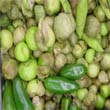Tomatillo (Physalis ixocarpa) is known in Mexico as tomate verde (green tomato), tomate de cascara (husk tomato), and miltomate, though it is not a tomato at all. In actuality it is related to the Cape gooseberry and American ground cherry. In all three of these the fruit (a small to medium berry) is encased in a thin, paper-like translucent outer skin that must be removed before cooking. According to Teresa Castello Yturbide in Presencia de la Comida Prehispanica, tomatillo husks furnish a leavening agent when boiled in agua de tequesquite (see above). The fruit is bright green, yellow-green, or sometimes purple, and can vary in size from a marble to a Ping-pong ball.
Fresh tomatillos are widely available in specialty groceries and some large supermarkets in the U.S. They are also sold in cans, dehusked. (I may be a minority, but I detest canned tomatillos.) The flavor of tomatillos is tart and refreshing and, I find, universally liked. They can be made into much the same kind of relishes, pickles, and raw or cooked sauces as tomatoes, except that their water content is less and the result will be thicker. Cooked tomatillo sauces jell to a curiously solid consistency when cooled, hence the old-fashioned name “jamberry” for the very similar ground cherry
See recipe section for various ways to prepare tomatillos including our famous salsa verde cruda.


